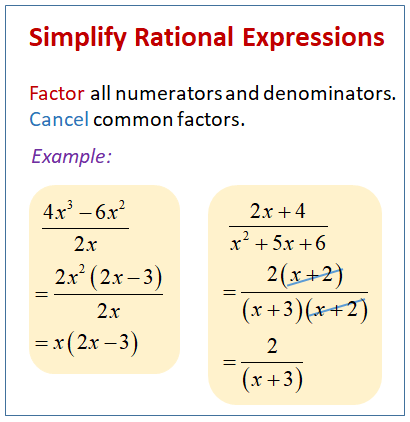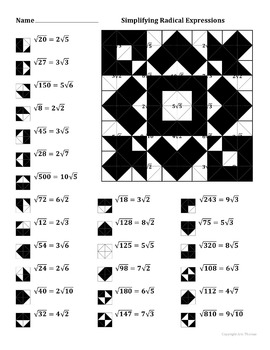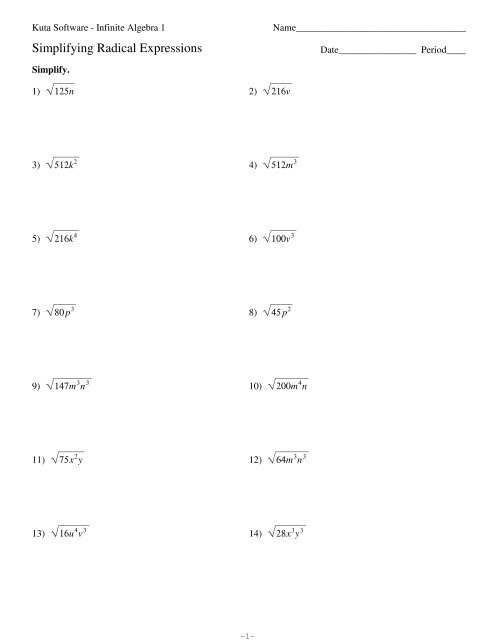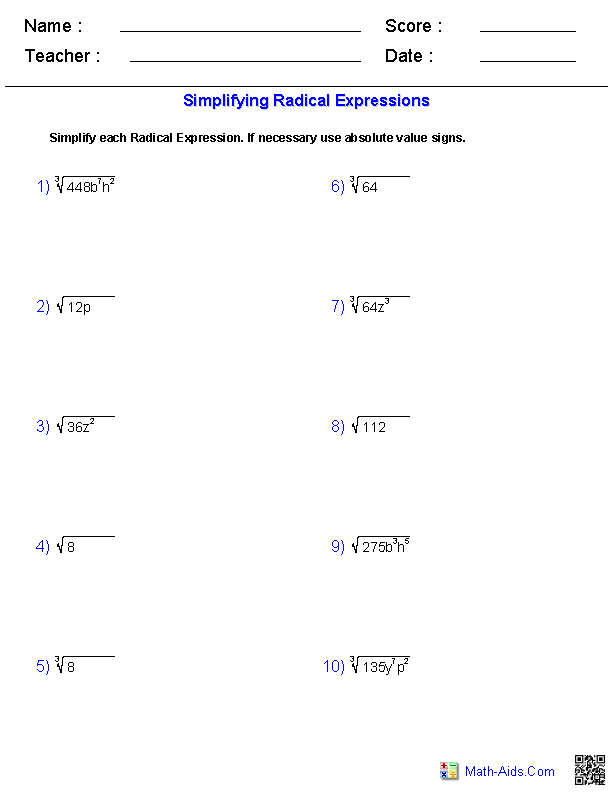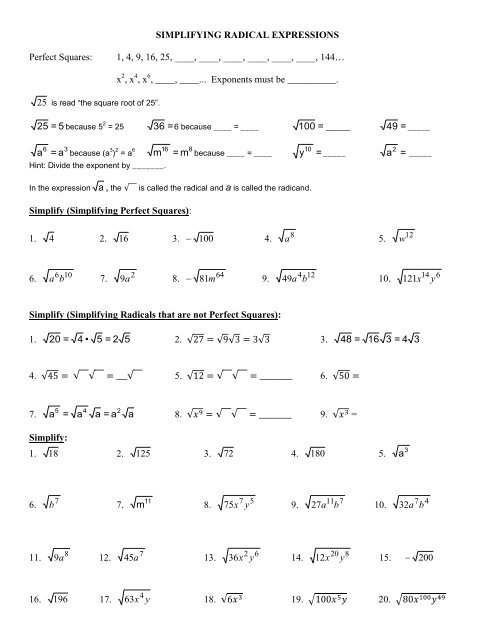Topic simplifying radical expressions with exponents: Simplifying radical expressions with exponents can seem challenging, but with the right techniques, it becomes manageable. This guide will help you understand and simplify these expressions, making your mathematical journey smoother and more enjoyable. Learn the fundamental rules, step-by-step processes, and common mistakes to avoid for a clear and concise mastery of radical expressions.
Table of Content
- Simplifying Radical Expressions with Exponents
- Introduction to Radical Expressions
- Understanding Exponents and Radicals
- Basic Rules for Simplifying Radical Expressions
- Converting Between Radical and Exponential Forms
- Common Mistakes and How to Avoid Them
- Examples of Simplifying Radical Expressions
- Advanced Techniques for Simplifying Radicals
- Practice Problems and Solutions
- Frequently Asked Questions
- Conclusion
- YOUTUBE: Hướng dẫn chi tiết cách đơn giản hóa các biểu thức có biến số, số mũ, phân số và căn bậc ba trong toán học đại số.
Simplifying Radical Expressions with Exponents
Radical expressions often involve roots and can be simplified using exponents. This process can make complex expressions easier to manage. Here is a guide to help you simplify radical expressions using exponents.
Understanding Radical and Exponential Forms
Radicals and exponents are two ways of representing the same mathematical concepts. For example, the square root of a number can be expressed as an exponent:
\(\sqrt{x} = x^{\frac{1}{2}}\)
Similarly, the nth root of a number can be expressed as:
\(\sqrt[n]{x} = x^{\frac{1}{n}}\)
Basic Rules for Simplifying
- Product Rule: \(\sqrt{a} \cdot \sqrt{b} = \sqrt{a \cdot b}\)
- Quotient Rule: \(\frac{\sqrt{a}}{\sqrt{b}} = \sqrt{\frac{a}{b}}\)
- Power Rule: \((\sqrt{a})^n = a^{\frac{n}{2}}\)
Steps to Simplify Radical Expressions
- Express the radical as an exponent.
- Simplify the exponent if possible.
- Convert back to radical form if necessary.
Examples
Example 1: Simplify \(\sqrt{x^6}\)
Step 1: Convert to exponential form: \(\sqrt{x^6} = (x^6)^{\frac{1}{2}}\)
Step 2: Simplify the exponent: \((x^6)^{\frac{1}{2}} = x^{6 \cdot \frac{1}{2}} = x^3\)
Final Answer: \(x^3\)
Example 2: Simplify \(\sqrt[3]{x^9}\)
Step 1: Convert to exponential form: \(\sqrt[3]{x^9} = (x^9)^{\frac{1}{3}}\)
Step 2: Simplify the exponent: \((x^9)^{\frac{1}{3}} = x^{9 \cdot \frac{1}{3}} = x^3\)
Final Answer: \(x^3\)
Common Mistakes to Avoid
- Not simplifying the exponent fully.
- Forgetting to convert back to radical form when needed.
- Confusing the product and quotient rules.
Practice Problems
- Simplify \(\sqrt{y^8}\)
- Simplify \(\sqrt[4]{z^{12}}\)
- Simplify \(\sqrt[5]{a^{10}}\)
Try these problems and use the steps outlined above to simplify each expression. Practice will help you become more comfortable with converting between radical and exponential forms.

READ MORE:
Introduction to Radical Expressions
Radical expressions involve roots, such as square roots or cube roots, and can be complex to simplify. Understanding the basics of radical expressions is essential for solving various mathematical problems. This section will guide you through the fundamentals of radical expressions and how to simplify them effectively.
A radical expression is an expression that includes a root symbol (√). The number or expression inside the root symbol is called the radicand. For example, in the expression \(\sqrt{16}\), 16 is the radicand.
Key Concepts
- Square Root: The square root of a number \(x\) is a number \(y\) such that \(y^2 = x\). It is denoted as \(\sqrt{x}\).
- Cube Root: The cube root of a number \(x\) is a number \(y\) such that \(y^3 = x\). It is denoted as \(\sqrt[3]{x}\).
- n-th Root: The n-th root of a number \(x\) is a number \(y\) such that \(y^n = x\). It is denoted as \(\sqrt[n]{x}\).
Properties of Radicals
To simplify radical expressions, you need to understand several key properties:
- Product Property: \(\sqrt{a \cdot b} = \sqrt{a} \cdot \sqrt{b}\)
- Quotient Property: \(\sqrt{\frac{a}{b}} = \frac{\sqrt{a}}{\sqrt{b}}\)
- Power of a Radical: \((\sqrt[n]{a})^m = a^{\frac{m}{n}}\)
Steps to Simplify Radical Expressions
- Identify the radicand and the root.
- Express the radical as an exponent.
- Use the properties of exponents to simplify the expression.
- Convert back to radical form if needed.
Example
Simplify \(\sqrt{50}\):
- Identify the radicand: 50.
- Factor the radicand into prime factors: \(50 = 2 \times 5^2\).
- Apply the product property: \(\sqrt{50} = \sqrt{2 \times 5^2} = \sqrt{2} \times \sqrt{5^2}\).
- Simplify the square root: \(\sqrt{5^2} = 5\).
- Combine the results: \(\sqrt{50} = 5\sqrt{2}\).
Understanding and simplifying radical expressions with exponents is a crucial skill in algebra and higher-level mathematics. By following these steps and applying the properties of radicals, you can simplify complex expressions and solve problems more efficiently.
Understanding Exponents and Radicals
Exponents and radicals are fundamental concepts in mathematics that help us express and simplify large numbers and complex expressions. This section will provide a comprehensive understanding of exponents and radicals, their properties, and how they relate to each other.
Exponents
An exponent indicates how many times a number, known as the base, is multiplied by itself. For example, in \(a^n\), \(a\) is the base and \(n\) is the exponent, meaning \(a\) is multiplied by itself \(n\) times:
\(a^n = a \cdot a \cdot a \cdots a\) (n times)
Properties of Exponents
- Product of Powers: \(a^m \cdot a^n = a^{m+n}\)
- Quotient of Powers: \(\frac{a^m}{a^n} = a^{m-n}\)
- Power of a Power: \((a^m)^n = a^{m \cdot n}\)
- Power of a Product: \((a \cdot b)^n = a^n \cdot b^n\)
- Power of a Quotient: \(\left(\frac{a}{b}\right)^n = \frac{a^n}{b^n}\)
Radicals
Radicals, or roots, are the opposite of exponents. The most common radical is the square root, but there are also cube roots, fourth roots, etc. The n-th root of a number \(a\) is a value that, when raised to the power of \(n\), gives \(a\). It is denoted as \(\sqrt[n]{a}\).
For example, \(\sqrt[3]{8} = 2\) because \(2^3 = 8\).
Properties of Radicals
- Product Property: \(\sqrt[n]{a \cdot b} = \sqrt[n]{a} \cdot \sqrt[n]{b}\)
- Quotient Property: \(\sqrt[n]{\frac{a}{b}} = \frac{\sqrt[n]{a}}{\sqrt[n]{b}}\)
- Power of a Radical: \((\sqrt[n]{a})^m = a^{\frac{m}{n}}\)
Relationship Between Exponents and Radicals
Radicals can be expressed as exponents with fractional values. For example:
\(\sqrt{a} = a^{\frac{1}{2}}\)
\(\sqrt[3]{a} = a^{\frac{1}{3}}\)
In general, \(\sqrt[n]{a} = a^{\frac{1}{n}}\).
Examples
Convert the following radicals to exponential form:
- \(\sqrt{16} = 16^{\frac{1}{2}} = 4\)
- \(\sqrt[3]{27} = 27^{\frac{1}{3}} = 3\)
- \(\sqrt[4]{81} = 81^{\frac{1}{4}} = 3\)
Understanding exponents and radicals and their relationship is crucial for simplifying and solving mathematical expressions. By mastering these concepts, you can tackle a wide range of mathematical problems with confidence.
Basic Rules for Simplifying Radical Expressions
Simplifying radical expressions involves using several fundamental rules that help in breaking down and combining radicals effectively. These rules are essential for simplifying complex expressions and solving mathematical problems involving radicals and exponents.
Product Rule
The product rule for radicals states that the radical of a product is equal to the product of the radicals:
\(\sqrt[n]{a \cdot b} = \sqrt[n]{a} \cdot \sqrt[n]{b}\)
Example:
Simplify \(\sqrt{50}\):
- Express 50 as a product of its prime factors: \(50 = 2 \cdot 25\).
- Apply the product rule: \(\sqrt{50} = \sqrt{2 \cdot 25} = \sqrt{2} \cdot \sqrt{25}\).
- Simplify the radicals: \(\sqrt{25} = 5\).
- Combine the results: \(\sqrt{50} = 5\sqrt{2}\).
Quotient Rule
The quotient rule for radicals states that the radical of a quotient is equal to the quotient of the radicals:
\(\sqrt[n]{\frac{a}{b}} = \frac{\sqrt[n]{a}}{\sqrt[n]{b}}\)
Example:
Simplify \(\sqrt{\frac{18}{2}}\):
- Express the fraction: \(\frac{18}{2} = 9\).
- Apply the quotient rule: \(\sqrt{\frac{18}{2}} = \sqrt{9}\).
- Simplify the radical: \(\sqrt{9} = 3\).
- Result: \(\sqrt{\frac{18}{2}} = 3\).
Power Rule
The power rule for radicals states that a radical raised to an exponent can be simplified by multiplying the exponent with the fractional exponent of the radical:
\((\sqrt[n]{a})^m = a^{\frac{m}{n}}\)
Example:
Simplify \((\sqrt{7})^4\):
- Convert the radical to exponential form: \(\sqrt{7} = 7^{\frac{1}{2}}\).
- Apply the power rule: \((7^{\frac{1}{2}})^4 = 7^{\frac{4}{2}} = 7^2\).
- Simplify the exponent: \(7^2 = 49\).
- Result: \((\sqrt{7})^4 = 49\).
Simplifying Higher-Order Radicals
For higher-order radicals, such as cube roots or fourth roots, the same rules apply but with appropriate adjustments for the order of the root:
Example:
Simplify \(\sqrt[3]{27}\):
- Recognize that 27 is a perfect cube: \(27 = 3^3\).
- Apply the property of cube roots: \(\sqrt[3]{27} = \sqrt[3]{3^3}\).
- Simplify the radical: \(\sqrt[3]{3^3} = 3\).
- Result: \(\sqrt[3]{27} = 3\).
By understanding and applying these basic rules, you can simplify a wide range of radical expressions. Practice these techniques regularly to become proficient in simplifying radicals.
Converting Between Radical and Exponential Forms
Understanding how to convert between radical and exponential forms is crucial for simplifying and manipulating expressions in algebra. This process involves expressing radicals as exponents and vice versa, which can simplify complex calculations.
From Radicals to Exponents
Radicals can be expressed as fractional exponents. The general form is:
\(\sqrt[n]{a} = a^{\frac{1}{n}}\)
where \(n\) is the index of the radical, and \(a\) is the radicand.
Examples
- \(\sqrt{a} = a^{\frac{1}{2}}\)
- \(\sqrt[3]{a} = a^{\frac{1}{3}}\)
- \(\sqrt[4]{a} = a^{\frac{1}{4}}\)
From Exponents to Radicals
Exponents with fractional values can be converted to radical form. The general form is:
\(a^{\frac{m}{n}} = \sqrt[n]{a^m}\)
where \(m\) is the power, and \(n\) is the root.
Examples
- \(a^{\frac{1}{2}} = \sqrt{a}\)
- \(a^{\frac{1}{3}} = \sqrt[3]{a}\)
- \(a^{\frac{2}{3}} = \sqrt[3]{a^2}\)
Steps for Conversion
To convert between radical and exponential forms, follow these steps:
Radical to Exponential
- Identify the radicand \(a\) and the index \(n\).
- Express the radical as a fractional exponent: \(\sqrt[n]{a} = a^{\frac{1}{n}}\).
Exponential to Radical
- Identify the base \(a\), the power \(m\), and the root \(n\).
- Express the exponent as a radical: \(a^{\frac{m}{n}} = \sqrt[n]{a^m}\).
Practice Problems
Convert the following expressions between radical and exponential forms:
| Radical Form | Exponential Form |
|---|---|
| \(\sqrt{7}\) | \(7^{\frac{1}{2}}\) |
| \(\sqrt[3]{5}\) | \(5^{\frac{1}{3}}\) |
| \(\sqrt[4]{16}\) | \(16^{\frac{1}{4}}\) |
| \(2^{\frac{3}{2}}\) | \(\sqrt{2^3}\) or \(\sqrt{8}\) |
| \(9^{\frac{2}{3}}\) | \(\sqrt[3]{9^2}\) or \(\sqrt[3]{81}\) |
By mastering these conversions, you will enhance your ability to simplify and solve a wide range of mathematical problems efficiently. Practice regularly to gain confidence in switching between radical and exponential forms.

Common Mistakes and How to Avoid Them
Simplifying radical expressions with exponents can sometimes lead to common mistakes. Understanding these errors and learning how to avoid them can help in achieving accurate results.
Mistake 1: Incorrectly Simplifying the Radicand
One common mistake is not fully simplifying the radicand before applying radical rules.
Example:
Simplify \(\sqrt{18}\):
- Incorrect approach: \(\sqrt{18} = 18^{\frac{1}{2}}\).
- Correct approach: Factorize 18: \(18 = 9 \cdot 2\).
- Apply the product rule: \(\sqrt{18} = \sqrt{9 \cdot 2} = \sqrt{9} \cdot \sqrt{2}\).
- Simplify: \(\sqrt{9} = 3\).
- Result: \(\sqrt{18} = 3\sqrt{2}\).
Mistake 2: Misapplying the Product Rule
The product rule states that \(\sqrt{a \cdot b} = \sqrt{a} \cdot \sqrt{b}\). Misapplying this rule can lead to incorrect results.
Example:
Simplify \(\sqrt{12 \cdot 3}\):
- Incorrect approach: \(\sqrt{12 \cdot 3} = \sqrt{36} = 6\).
- Correct approach: Apply the product rule correctly: \(\sqrt{12 \cdot 3} = \sqrt{12} \cdot \sqrt{3}\).
- Simplify each radical: \(\sqrt{12} = 2\sqrt{3}\), so \(\sqrt{12 \cdot 3} = 2\sqrt{3} \cdot \sqrt{3} = 2 \cdot 3 = 6\).
Mistake 3: Ignoring the Index of the Radical
Another common mistake is not paying attention to the index of the radical, especially when dealing with higher-order roots.
Example:
Simplify \(\sqrt[3]{8}\):
- Incorrect approach: Treating it as a square root: \(\sqrt{8}\).
- Correct approach: Recognize the cube root: \(\sqrt[3]{8} = \sqrt[3]{2^3}\).
- Simplify: \(\sqrt[3]{2^3} = 2\).
- Result: \(\sqrt[3]{8} = 2\).
Mistake 4: Incorrectly Rationalizing the Denominator
When rationalizing the denominator, ensure that the process is applied correctly to avoid errors.
Example:
Simplify \(\frac{1}{\sqrt{2}}\):
- Incorrect approach: \(\frac{1}{\sqrt{2}} = \sqrt{\frac{1}{2}}\).
- Correct approach: Multiply numerator and denominator by \(\sqrt{2}\): \(\frac{1}{\sqrt{2}} \cdot \frac{\sqrt{2}}{\sqrt{2}} = \frac{\sqrt{2}}{2}\).
Mistake 5: Combining Unlike Radicals
Ensure only like radicals are combined. Unlike radicals cannot be simplified together.
Example:
Simplify \(2\sqrt{3} + 4\sqrt{2}\):
- Incorrect approach: Adding directly: \(2\sqrt{3} + 4\sqrt{2} = 6\sqrt{5}\).
- Correct approach: Recognize unlike radicals cannot be combined: \(2\sqrt{3} + 4\sqrt{2}\) remains as it is.
Practice Problems
Test your understanding by simplifying the following expressions:
| Expression | Steps | Simplified Form |
|---|---|---|
| \(\sqrt{75}\) |
|
\(5\sqrt{3}\) |
| \(\sqrt[3]{27}\) |
|
\(3\) |
| \(\frac{2}{\sqrt{5}}\) |
|
\(\frac{2\sqrt{5}}{5}\) |
By being aware of these common mistakes and learning how to avoid them, you can improve your skills in simplifying radical expressions and achieve more accurate results. Practice regularly to reinforce these concepts and gain confidence.
Examples of Simplifying Radical Expressions
In this section, we will look at various examples to illustrate how to simplify radical expressions. Each example is broken down step by step to ensure clarity and understanding.
Example 1: Simplifying \(\sqrt{50}\)
- Identify factors of 50: \(50 = 25 \cdot 2\).
- Apply the product rule of radicals: \(\sqrt{50} = \sqrt{25 \cdot 2} = \sqrt{25} \cdot \sqrt{2}\).
- Simplify \(\sqrt{25}\): \(\sqrt{25} = 5\).
- Combine the simplified terms: \(\sqrt{50} = 5\sqrt{2}\).
Example 2: Simplifying \(\sqrt[3]{54}\)
- Identify factors of 54: \(54 = 27 \cdot 2\).
- Apply the product rule for cube roots: \(\sqrt[3]{54} = \sqrt[3]{27 \cdot 2} = \sqrt[3]{27} \cdot \sqrt[3]{2}\).
- Simplify \(\sqrt[3]{27}\): \(\sqrt[3]{27} = 3\).
- Combine the simplified terms: \(\sqrt[3]{54} = 3\sqrt[3]{2}\).
Example 3: Simplifying \(\frac{1}{\sqrt{5}}\)
- Rationalize the denominator by multiplying the numerator and the denominator by \(\sqrt{5}\): \(\frac{1}{\sqrt{5}} \cdot \frac{\sqrt{5}}{\sqrt{5}} = \frac{\sqrt{5}}{5}\).
- Result: \(\frac{1}{\sqrt{5}} = \frac{\sqrt{5}}{5}\).
Example 4: Simplifying \(\sqrt{18} + \sqrt{8}\)
- Simplify each radical separately:
- \(\sqrt{18} = \sqrt{9 \cdot 2} = \sqrt{9} \cdot \sqrt{2} = 3\sqrt{2}\).
- \(\sqrt{8} = \sqrt{4 \cdot 2} = \sqrt{4} \cdot \sqrt{2} = 2\sqrt{2}\).
- Combine like terms: \(3\sqrt{2} + 2\sqrt{2} = (3 + 2)\sqrt{2} = 5\sqrt{2}\).
Example 5: Simplifying \(\sqrt{12} \cdot \sqrt{3}\)
- Apply the product rule of radicals: \(\sqrt{12} \cdot \sqrt{3} = \sqrt{12 \cdot 3} = \sqrt{36}\).
- Simplify \(\sqrt{36}\): \(\sqrt{36} = 6\).
- Result: \(\sqrt{12} \cdot \sqrt{3} = 6\).
Example 6: Simplifying \(\sqrt{72}\)
- Identify factors of 72: \(72 = 36 \cdot 2\).
- Apply the product rule of radicals: \(\sqrt{72} = \sqrt{36 \cdot 2} = \sqrt{36} \cdot \sqrt{2}\).
- Simplify \(\sqrt{36}\): \(\sqrt{36} = 6\).
- Combine the simplified terms: \(\sqrt{72} = 6\sqrt{2}\).
Practice Problems
Try simplifying the following radical expressions:
| Expression | Steps | Simplified Form |
|---|---|---|
| \(\sqrt{45}\) |
|
\(3\sqrt{5}\) |
| \(\sqrt[3]{64}\) |
|
\(4\) |
| \(\frac{2}{\sqrt{7}}\) |
|
\(\frac{2\sqrt{7}}{7}\) |
By working through these examples, you will gain a better understanding of how to simplify radical expressions. Practice regularly to enhance your skills and confidence.
Advanced Techniques for Simplifying Radicals
In this section, we will explore advanced techniques for simplifying radical expressions, particularly those involving exponents and higher-order roots. These techniques build upon the basic principles of radicals and exponents, enabling you to handle more complex expressions efficiently.
1. Using Rational Exponents
Rational exponents can simplify the process of working with radicals. Recall that an expression with a radical can be written using a rational exponent:
\[ \sqrt[n]{a^m} = a^{\frac{m}{n}} \]
For example:
\[ \sqrt[4]{16} = 16^{\frac{1}{4}} \]
And since \(16 = 2^4\), it follows that:
\[ 16^{\frac{1}{4}} = (2^4)^{\frac{1}{4}} = 2 \]
2. Simplifying Higher-Order Roots
When simplifying expressions with higher-order roots, factor each term under the radical into its prime factors, then simplify:
Example:
\[ \sqrt[3]{54a^6b^3} \]
First, factor inside the radical:
\[ 54 = 2 \cdot 3^3 \]
\[ \sqrt[3]{2 \cdot 3^3 \cdot a^6 \cdot b^3} \]
Separate the factors and simplify:
\[ \sqrt[3]{2} \cdot \sqrt[3]{3^3} \cdot \sqrt[3]{a^6} \cdot \sqrt[3]{b^3} \]
Using the property \(\sqrt[3]{x^3} = x\), we get:
\[ \sqrt[3]{2} \cdot 3 \cdot a^2 \cdot b \]
3. The Product and Quotient Rules for Radicals
These rules are useful for breaking down complex radical expressions:
- Product Rule: \(\sqrt[n]{ab} = \sqrt[n]{a} \cdot \sqrt[n]{b}\)
- Quotient Rule: \(\sqrt[n]{\frac{a}{b}} = \frac{\sqrt[n]{a}}{\sqrt[n]{b}}\)
Example:
\[ \sqrt[4]{81x^8y^3} \]
Rewrite and factor inside the radical:
\[ \sqrt[4]{3^4 \cdot (x^2)^4 \cdot y^3} \]
Separate the factors:
\[ \sqrt[4]{3^4} \cdot \sqrt[4]{(x^2)^4} \cdot \sqrt[4]{y^3} \]
Simplify each part:
\[ 3 \cdot x^2 \cdot \sqrt[4]{y^3} \]
4. Combining Rational Exponents and Radicals
When working with expressions that involve both radicals and rational exponents, convert all terms to rational exponents to simplify:
Example:
\[ \frac{10b^2c^2}{c\sqrt[3]{8b^4}} \]
Rewrite the denominator with rational exponents:
\[ \frac{10b^2c^2}{c \cdot 8^{1/3} \cdot b^{4/3}} \]
Simplify using the properties of exponents:
\[ \frac{10b^2c^2}{c \cdot 2 \cdot b^{4/3}} \]
Combine like terms:
\[ \frac{10b^{2 - 4/3}c^2}{2c} \]
\[ \frac{10b^{6/3 - 4/3}c^2}{2c} = \frac{10b^{2/3}c^2}{2c} = 5b^{2/3}c \]
By mastering these advanced techniques, you will be well-equipped to simplify even the most complex radical expressions efficiently.
Practice Problems and Solutions
Below are some practice problems and their solutions to help you master simplifying radical expressions with exponents:
Problem 1
Simplify \( \sqrt{72} \)
Solution:
- Find the largest perfect square factor of 72, which is 36.
- Rewrite the expression: \( \sqrt{72} = \sqrt{36 \times 2} \)
- Apply the product rule of square roots: \( \sqrt{36 \times 2} = \sqrt{36} \times \sqrt{2} \)
- Simplify: \( \sqrt{36} = 6 \), so \( \sqrt{72} = 6\sqrt{2} \)
Therefore, \( \sqrt{72} = 6\sqrt{2} \).
Problem 2
Simplify \( \sqrt[3]{54a^{10}b^{16}c^7} \)
Solution:
- Rewrite the expression with rational exponents: \( 54a^{10}b^{16}c^7 = (54)^{1/3} \cdot (a^{10})^{1/3} \cdot (b^{16})^{1/3} \cdot (c^7)^{1/3} \)
- Simplify each part:
- \( (54)^{1/3} \approx 3.78 \)
- \( (a^{10})^{1/3} = a^{10/3} \)
- \( (b^{16})^{1/3} = b^{16/3} \)
- \( (c^7)^{1/3} = c^{7/3} \)
- Combine the results: \( 3.78a^{10/3}b^{16/3}c^{7/3} \)
Therefore, \( \sqrt[3]{54a^{10}b^{16}c^7} \approx 3.78a^{10/3}b^{16/3}c^{7/3} \).
Problem 3
Simplify \( \sqrt{12x^2y^4} \)
Solution:
- Rewrite the expression: \( \sqrt{12x^2y^4} = \sqrt{4 \times 3 \times x^2 \times y^4} \)
- Apply the product rule: \( \sqrt{4} \times \sqrt{3} \times \sqrt{x^2} \times \sqrt{y^4} \)
- Simplify each part:
- \( \sqrt{4} = 2 \)
- \( \sqrt{3} \) remains as \( \sqrt{3} \)
- \( \sqrt{x^2} = x \)
- \( \sqrt{y^4} = y^2 \)
- Combine the results: \( 2xy^2\sqrt{3} \)
Therefore, \( \sqrt{12x^2y^4} = 2xy^2\sqrt{3} \).
Problem 4
Simplify \( \sqrt[4]{16x^8y^{12}} \)
Solution:
- Rewrite the expression with rational exponents: \( 16x^8y^{12} = (16)^{1/4} \cdot (x^8)^{1/4} \cdot (y^{12})^{1/4} \)
- Simplify each part:
- \( (16)^{1/4} = 2 \)
- \( (x^8)^{1/4} = x^2 \)
- \( (y^{12})^{1/4} = y^3 \)
- Combine the results: \( 2x^2y^3 \)
Therefore, \( \sqrt[4]{16x^8y^{12}} = 2x^2y^3 \).

Frequently Asked Questions
-
What is a radical expression?
A radical expression is any mathematical expression containing a radical symbol (√) with a radicand (the number inside the radical symbol).
-
How do you simplify a radical expression with exponents?
To simplify radical expressions with exponents:
- Identify and separate the coefficients and variables.
- Apply the rule
\(\sqrt[n]{a^n} = a\)where possible. - Use prime factorization for numbers and reduce variables using their exponents.
- Combine like terms and rewrite the expression.
For example, simplify
\(\sqrt[3]{27x^6}\):\(\sqrt[3]{27x^6} = 3x^2\)
-
What is the difference between radicals and exponents?
Radicals involve roots (e.g., square root, cube root), while exponents represent repeated multiplication. They are inverse operations:
\(x^{1/n} = \sqrt[n]{x}\). -
How do you convert between radical and exponential forms?
Use the property
\(\sqrt[n]{x^m} = x^{m/n}\)to convert a radical expression to its exponential form and vice versa. -
Can you simplify radicals with different indices?
Yes, rewrite them with a common index by finding the least common multiple (LCM) of the indices. For example,
\(\sqrt[3]{x}\) and \(\sqrt[4]{x}\)can be rewritten as\(x^{4/12}\) and \(x^{3/12}\). -
What are some common mistakes when simplifying radicals?
Common mistakes include:
- Not simplifying completely.
- Forgetting to apply absolute values for even roots.
- Ignoring the properties of exponents and radicals.
-
Why do we need to simplify radical expressions?
Simplifying radicals helps in solving equations, evaluating expressions more easily, and preparing expressions for further algebraic manipulation.
-
How do you handle radicals in the denominator?
To rationalize a denominator containing radicals, multiply the numerator and the denominator by the conjugate or an appropriate radical to eliminate the radical from the denominator.
Conclusion
In conclusion, simplifying radical expressions with exponents is a fundamental skill in algebra that combines knowledge of exponents and roots. By following the steps outlined in this guide, you can confidently tackle a variety of expressions. Here are some key takeaways:
- Understand the Basics: Recognize that radicals and exponents are interconnected. Remember that \(\sqrt[n]{x^m} = x^{\frac{m}{n}}\) and practice converting between these forms.
- Apply the Product and Quotient Rules: Use the rules \(\sqrt{a} \cdot \sqrt{b} = \sqrt{ab}\) and \(\frac{\sqrt{a}}{\sqrt{b}} = \sqrt{\frac{a}{b}}\) to simplify expressions involving multiple terms.
- Break Down the Radicand: Factor the number or expression inside the radical. Identify perfect squares or cubes, and simplify them outside the radical.
- Simplify Variables: Apply the properties of exponents to variables. Remember that \(\sqrt{x^2} = |x|\) to account for non-negative results.
- Use Absolute Values: When dealing with even roots of variables, use absolute values to ensure that the expression remains non-negative.
- Practice with Complex Expressions: Tackle more challenging problems by breaking them down into simpler components, applying the rules methodically.
By mastering these techniques, you enhance your mathematical skills, making it easier to solve equations, understand functions, and apply these concepts in real-world situations. Remember, practice is key to becoming proficient in simplifying radical expressions. Keep challenging yourself with varied problems to build confidence and expertise.
We hope this guide has been helpful, and we encourage you to continue exploring the fascinating world of algebra!
Hướng dẫn chi tiết cách đơn giản hóa các biểu thức có biến số, số mũ, phân số và căn bậc ba trong toán học đại số.
Đơn Giản Hóa Biểu Thức Có Biến Số, Số Mũ, Phân Số, Căn Bậc Ba - Đại Số
READ MORE:
Hướng dẫn chi tiết cách đơn giản hóa các biểu thức căn bậc hai có biến số và số mũ, giúp bạn nắm vững kiến thức toán học cơ bản.
Đơn Giản Hóa Biểu Thức Căn Bậc Hai với Biến Số và Số Mũ



